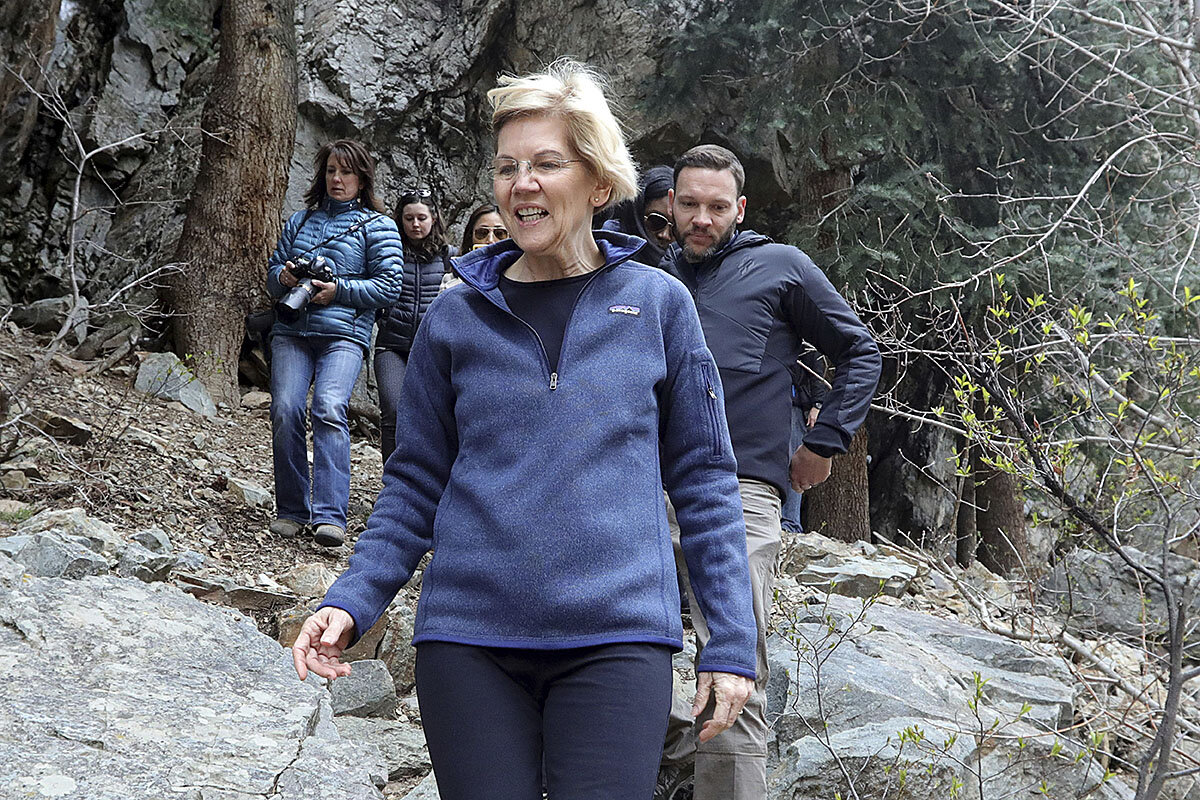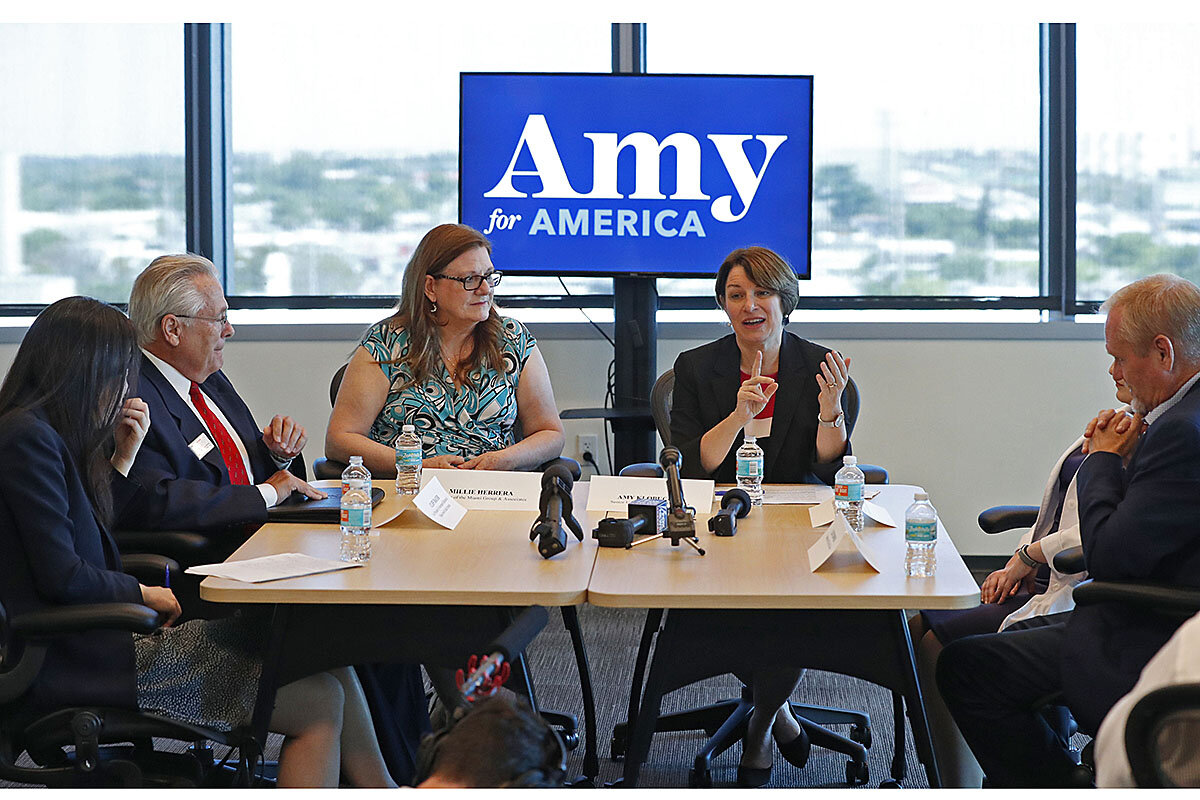With so many women running for president, why is focus still on the men?
Loading...
As the 2020 Democratic field expands to 20 candidates this week, with the expected entrance of former Vice President Joe Biden, a glaring discrepancy looms over the race: It’s a quartet of white men – Mr. Biden, Vermont Sen. Bernie Sanders, former Texas Rep. Beto O’Rourke, and South Bend, Indiana, Mayor Pete Buttigieg – who are attracting the most media attention. And with the exception of California Sen. Kamala Harris, the record six women running for president are generally lagging behind the men in polling and fundraising.
This is particularly frustrating to supporters of Sen. Elizabeth Warren, a janitor’s daughter turned Harvard law professor who has dedicated her life to fighting income inequality in the United States.
“I Can’t Believe Elizabeth Warren Is Losing to These Guys,” trumpets a headline in Jacobin. “Elizabeth Warren, Hillary Clinton and the sexist hypocrisy of the ‘likability’ media narrative. Here we go again,” offers an NBC piece. And from WBUR in Senator Warren’s home state of Massachusetts: “Elizabeth Warren Doesn’t Have a DNA Problem. She Has A Sexism Problem.” (All three pieces were written by men.)
Why We Wrote This
Much has been made of the surge of women candidates. But media coverage – and entrenched assumptions about what makes a strong candidate – may not have caught up with the dramatic shift.
Just a few months after the “Year of the Woman” brought female representation in Congress to a record high, the glass ceiling of presidential elections is looking harder to shatter. Some suggest gender bias may be depriving the half-dozen women candidates of the media coverage they deserve, which at this stage in the race can dramatically influence their polling and fundraising numbers.
“It’s skewing the way we’re talking about these candidates very early on, when the media has an outsized potential to shape primaries,” says Lauren Leader, CEO of All In Together whose op-ed for The Hill last week, “We seem to be ignoring the women running for president,” got 50,000 shares in two days.
By many measurements, women have a better chance than ever before of reaching the White House. Voter resistance to female candidates (based on responses to the question “are men better suited emotionally for politics than most women?”) has dropped to a record low of 13 percent. That’s about a 25% improvement since 2016, when Hillary Clinton got nearly 3 million more votes than Donald Trump.
“[The candidates] have just got to stay the course and not get sucked into feeling that they need to out-shout the men, or out-thump their chests, but look for every opportunity to reach out to voters,” says Christine Todd Whitman, who overcame a 21% polling gap to become the first female governor of New Jersey in 1993. “Women do that well. ... They listen sometimes in a way that their male counterparts don’t.”
Yet when it comes to the main indicators of how much traction candidates are getting – media coverage, fundraising, and polling – the women are conspicuously lagging, with none doing well in all three categories.
By the numbers
Senator Warren and New York Sen. Kirsten Gillibrand are doing about equally badly in all three categories, but Senator Harris and Sen. Amy Klobuchar of Minnesota are getting substantially less media coverage than their fundraising and polling numbers would suggest.
Senator Harris is running third in the latest Morning Consult poll and has raised more money than any Democratic contender except Senator Sanders. However, she’s been mentioned only about half as many times as Mayor Buttigieg on major cable news channels recently – though that was during a time period leading up to the formal announcement of his candidacy. Similarly, Senator Klobuchar came in sixth in fundraising for the first quarter but ranks 10th in recent media mentions.
“All most men have to do is be mayor of a small town, turn 37, and say I’m running for office,” says Nichole Bauer, who teaches political communication at Louisiana State University in Baton Rouge. Professor Bauer has run studies giving respondents the exact same information about hypothetical candidates and found they more often prefer the male version. “So I know it’s not just Hillary hate,” she says.
Of course, there are many factors that can determine media coverage, such as timing and novelty, and those can affect men as well. In 2016, for example, former Florida Gov. Jeb Bush outraised all 16 other candidates in the 2016 GOP primary race yet struggled to attract the spotlight. Indeed, Donald Trump’s ability to dominate the news cycle was a consistent source of frustration to all of his opponents.
“The 16 men who ran for the nomination for the Republicans would say the same thing – I’m jumping up and down here, why don’t you find me interesting?” says Kathleen Dolan, a political scientist at the University of Wisconsin, Milwaukee. “You had people who had all kinds of experience who couldn’t break through or crack through. So why do we expect a woman who is a senator from Minnesota … to be breaking through?”
A question of tone
But it’s not just the amount of coverage that matters; tone plays a big role as well. Many have seized on a recent media review from Northeastern University in Boston, which concluded that coverage of the female 2020 candidates has been more negative than that of their male counterparts. The unique words used to describe the women often had to do with controversies – such as Senator Warren’s Native American claims or Senator Klobuchar’s use of a comb to eat her salad after staffers failed to get her utensils before a flight – rather than substantive policy ideas or positive traits.
The study’s authors noted that their initial findings were based on a very limited sample of selected articles from the top five most-read publications.
“I was surprised at how quick people were to use it as evidence for this kind of sexism in media coverage or the campaign, when we were trying to be very clear up top that this is only 130 articles, this is not a truly random set of news publications, it’s just a starting point,” says Aleszu Bajak, who teaches courses on digital journalism, data reporting, and new media at Northeastern. “It’s a continuing research project.”
Professor Bajak says he and student Alexander Frandsen have since nearly doubled the data set to about 300 articles and are bringing in other colleagues to help with the growing project.
“We’ve added Buttigieg, who now seems to be blowing everyone out of the water in terms of positivity,” he says – but the women are still at the bottom.
Many scholars who study women in politics, most of whom are women themselves, say this is partially the result of political journalists being mostly male. According to the Women’s Media Center, men author nearly three-quarters of articles about U.S. elections on eight news websites, including The Washington Post and The New York Times online, CNN, Vox, and Fox. In the 14 print publications surveyed, the disparity is less glaring but still evident, with men writing 61% of articles.
To some, this imbalance in the gender makeup of the press corps makes media coverage prone to framing articles from a male perspective. For example, in evaluating a female candidate’s qualifications, they look for someone who is strong, rational, composed, and a fighter, says Meredith Conroy, a political scientist at California State University, San Bernardino.
“Women can try to contort themselves into this mold, but it’s harder,” says Professor Conroy, author of “Masculinity, Media, and the American Presidency.” “Men are inherently more congruent with this vision of the presidency, so their male behaviors are less likely to be questioned by the press.”
Take the issue of how a candidate treats his or her staff – a point on which Senator Klobuchar has been hammered hard.
“If it had been reported that Bernie had mistreated his staff, it would align with perceptions that he’s just an old grumpy man and that’s how he does business – that he’s gruff or curmudgeonly,” says Kelly Dittmar, a scholar at the Center for American Women and Politics at Rutgers University in New Jersey.
Still, just because gender bias may exist, that doesn’t mean it is the primary factor determining a candidate’s relative success or failure. Professor Dolan of the University of Wisconsin, for one, has become frustrated with how gender bias is being discussed relative to the presidential race.
“People can’t hold two things in their mind. Once they say there is gender bias at work, then the narrative becomes that everything about their candidacy” has to do with gender bias, she says.
She and others point out that the current crop of women candidates may well be suffering from a range of issues, from perceived charisma deficits to serious political missteps, that have thwarted plenty of men in previous primary seasons.
When it comes to Senator Warren, her struggles can be traced to how her campaign handled the Native American controversy on the eve of announcing her candidacy, says Alex Conant, a Republican strategist who helped Sen. Joni Ernst become the first woman to represent Iowa in Congress.
“You have one chance to introduce yourself to the electorate, and she really screwed that up,” he says. “If someone is claiming that Elizabeth Warren is not breaking through because of chronic sexism, that is making an excuse for an underperforming campaign.”








